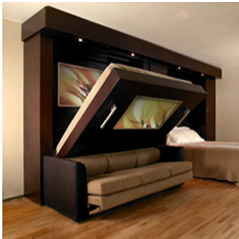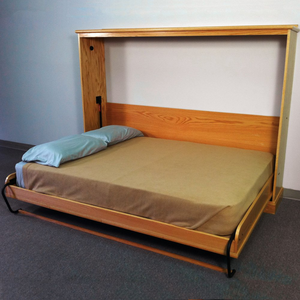
The Murphy Bed, otherwise called a divider bedwall bed with sofa overlay down bed or pull-down bed is a bed that is pivoted toward one side so it tends to be collapsed up and put away vertically against a divider or in a storage room. It’s valuable in circumstances where floor space is at a higher cost than expected, similar to studio condos, apartments, manufactured houses, and voyage transport lodges. The bed is named, nothing unexpected, after a person named Murphy—William L. Murphy. These sorts of beds had just been around in different structures for some time. Thomas Jefferson had his beds in Monticello holding tight ropes and snares in the niches of the rooms, and Leonard Bailey got the principal patent for a collapsing bed in 1899. Murphy’s advancement was at the bed’s place of collapsing. Utilizing an old storeroom doorjamb and some entryway pivots, he fabricated a turn that permitted the bed to connect to a divider and overlap facing it for simple stockpiling.
The child of a gold-chasing 49er, Murphy worked a couple of various employments around California before he thought of his development. He broke in ponies for some time, drove a stagecoach, and even filled in as sheriff of a little pioneer town. At the turn of the twentieth century, the advanced toward San Francisco and leased a little one-room loft on Bush Street, which motivated his jump into the bed business.

Murphy Bed Company:
The Murphy Bed Company says that Murphy’s standard bed took up a large portion of the condo’s floor space, which made having organization somewhat troublesome. Murphy needed to engage his companions at his home, so he started playing with the collapsing bed thought.
As Gene Kolakowski, an official at the organization, revealed to CBS News, however, there’s another starting point story where Murphy’s motivation was a lot more prominent. The form that Murphy’s relatives like to tell is that he structured the collapsing bed since he needed to have a specific youngster over to his place, however, the ethical principles of the time considered it improper to have a lady in his room. Edgy for some quality seeking time with the lady, Murphy was propelled to figure out how to right away transform his room into an increasingly blameless parlour.
Murphy, in the long run, wedded that equivalent young lady and utilized a credit from her dad to patent the “Murphy In-A-Dor Bed” and start his organization to make them. That equivalent organization keeps on making them today, right around 100 years after the fact. The beds aren’t as well known as they used to be, however. Request topped in the mid-1900s as assembling turned into the focal point of the American economy and individuals ran to occupations in urban regions. The debacle in the bed’s old neighbourhood caused a spike in deals, as well.
After the San Francisco Earthquake and Fire of 1906, the beds were set in numerous new and modified structures to amplify space (as indicated by Gladys Hansen, a custodian at the Museum of the City of San Francisco, a portion of the beds previously introduced in the city collapsed up viciously during the shudder, harming their inhabitants and executing at any rate one).
The Great Depression, the proportioning of steel and other crude materials during WWII, and the post-war rural lodging blast all cut into the collapsing bed business, yet the market is still large enough to help Murphy’s unique organization, in addition to a couple of contenders. In 1989 the courts decided that the “Murphy bed” was not, at this point qualified for brand name insurance because the general population had come to consider it to be a nonexclusive term for beds that overlap into dividers, regardless of whether they were Murphy’s structure or not.y were Murphy’s structure or not.
